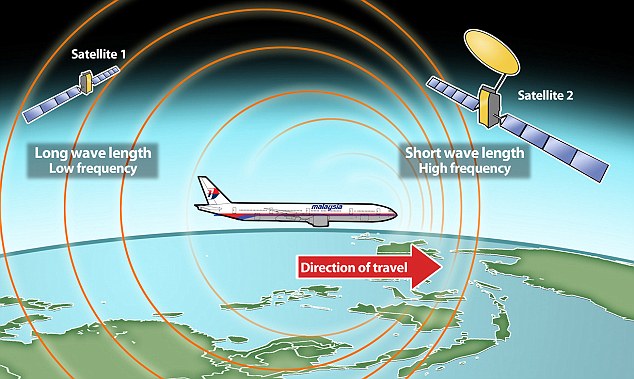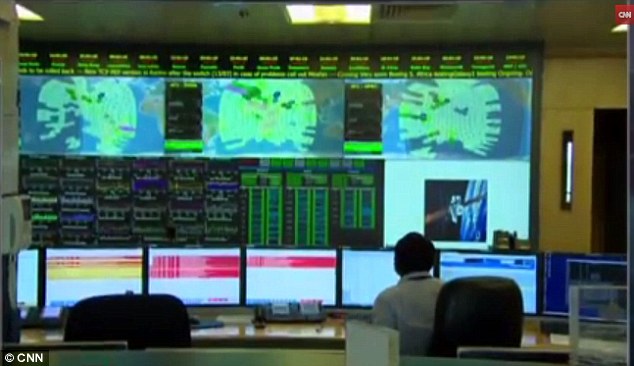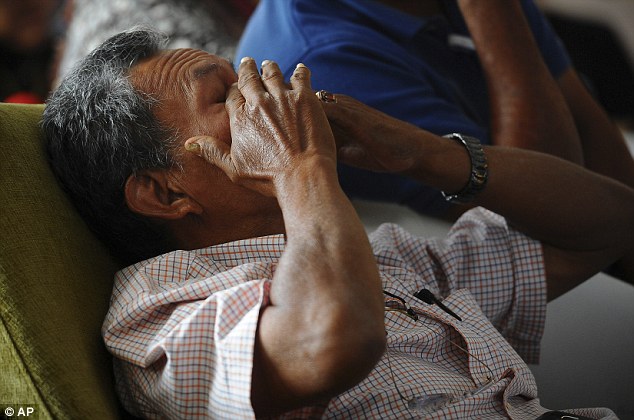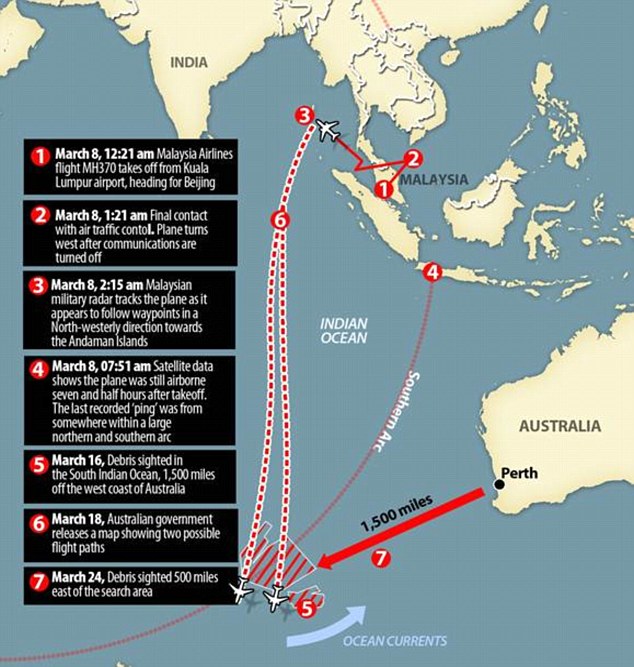
The new findings led Malaysian Prime Minister Najib Razak to conclude that the Boeing 777, which disappeared more than two weeks ago, crashed thousands of miles away in the southern Indian Ocean, killing everyone on board.
Investigators working on the disappearance of the plane believe that it may have been flown on a suicide mission.
Radar pings from MH370, automatically transmitted every hour from the aircraft after the rest of its communications systems had stopped, indicated it continued flying for hours after it disappeared from its flight path from Kuala Lumpur to Beijing.

Inmarsat's scientists then interrogated the faint pings using a technique based on the Doppler effect, which describes how a wave changes frequency relative to the movement of an observer, in this case the satellite, a spokesman said.
How INMARSAT Used The Doppler Effect To Track Down MH370's Last Known PositionBritain's Air Accidents Investigation Branch and experts from the European space industry were also involved in the analysis.
British satellite firm Inmarsat discovered on March 9 that MH370 had continued flying for at least another six hours after its last voice transmission from the cockpit at 1.19am on Saturday March 8.
It knew this from an electronic 'handshake' that the plane gave to one of its satellites. This placed it in one of two corridors, running north to kazakhstan, or south to the Indian Ocean.
The satellite received several more pings from the aircraft, but Inmarsat weren't immediately able to work out its trajectory because the satellite isn't GPS enabled.
However, the pings contained hidden clues in their wave frequencies. Inmarsat, using some very clever mathematical modelling, deduced that the frequency of the waves were changing in a way that gave away the plane's locations.
It's called the Doppler effect, named after the Austrian physicist Christian Doppler, who proposed it in 1842.
He noticed how wave frequencies changed as an observer moved around the source. In modern life we experience it frequently as the sounds of sirens from emergency service vehicles change as they move away from us.
A similar effect was occurring with MH370 that enabled Inmarsat to rule out a northerly trajectory. The frequencies of the pings it was returning meant it was travelling south.
The Doppler effect is why the sound of a police car siren changes as it approaches and then overtakes an observer.
Mr Razak said that British firm Inmarsat had employed 'a type of analysis never before used in an investigation of this sort'.
At a press conference in Kuala Lumpur today, Malaysia's transport minister Hishammuddin Hussein gave more details on how the authorities came to the conclusion that the flight had crashed in the southern Indian Ocean.
He said that the plane last communicated with a ground station at 12.11am, but had disappeared by 1.15am, suggesting that its systems either failed or were disabled at some time between those points.
'There is evidence of a partial handshake between the aircraft and ground station at 0019 UTC (GMT),' he said. 'At this time, this transmission is not understood and is subject to further ongoing work.'
The minister added: 'The new analysis was convincing enough to brief the prime minister that MH370 flew along the south corridor.

Mr Hussein confirmed that the search had been called off in the 'northern corridor' stretching up to the Caspian Sea, saying that it was now focussed on an area of 469,407 square miles to the south-west of Australia.
Malaysia Airlines chief executive Ahmad Jauhari Yahya said that the plane did not have enough fuel to stay in the air above the Indian Ocean for more than a few hours.
He added that the area where the flight is believed to have come down is so remote that the prospect of anyone on board surviving for more than two weeks is 'extremely remote'.
Speaking to BBC News today, Chris McLaughlin, Inmarsat's senior vice president, explained how his firm was able to conclude the aircraft definitely flew south.
He said: 'We took Malaysian 777 airline data and modeled that against the northern and southern path and what we discovered was that the path to the south is undoubtedly the one taken.'
Asked why it took so long, he said: 'We have been dealing with a totally new area, we have been trying to help an investigation based on a single signal once and hour from an aircraft that didn't include any GPS data or any time and distance information so this really was a bit of a shot in the dark and it is to the credit of our scientific team that they managed to model this.'
The new data revealed that MH370 flew along the southern corridor where investigators had said the plane could have travelled along, based on pings sent several hours after it disappeared on March 8.
Investigators had drawn up two huge search areas in two large arcs - a northern corridor stretching from Malaysia to Central Asia and a southern corridor extending down towards Antartica.
Timeline Of INMARSAT'S Data CrunchingMalaysian Prime Minister Razak last night delivered the chilling news that all on board had been killed, concluding the doomed airliner crashed into the southern Indian Ocean - where search teams are still scouring for any sign of wreckage.
Sunday March 9
Inmarsat discovered that the plane had been flying for a further six hours after its last contact with air traffic controllers on March 8.
Sunday March 9 and Monday March 10
Studied data to confirm this was the case
Tuesday March 11
Established that aircraft was moving either north or south towards the Indian Ocean
Between March 11 and 23
Inmarsat crunched the data and looked at ping returns from comparable Boeing flights, eventually ruling out a northerly trajectory.
This data was peer reviewed by colleagues and scientists in Europe's space industry.
Monday March 24
Result - that southern route was the only route - submitted to the UK Air Accidents Investigation Branch.
Chris McLaughlin, Senior Vice President, External Affairs, at Inmarsat, told MailOnline that the data couldn't be released immediately because it 'was being cross-checked by all manner of parties'.
But that search has been held up by adverse weather conditions, which prompted the Australian Maritime Safety Authority (AMSA) to suspend operations for at least 24 hours, it was announced Tuesday.
The search involves ships and planes from the United States, China, Japan, Australia, New Zealand and South Korea.
Malaysia said the U.S. Navy will deliver a black box pinger locator to Perth on Wednesday. The Australian warship that will tow the locator is due to arrive in the search area on April 5. By then, there may be little time left.
The team trying to piece together just what happened to MH370 are convinced that someone on board the plane crashed it to commit suicide.
An unnamed source told the Telegraph: 'This has been a deliberate act by someone on board who had to have had the detailed knowledge to do what was done... Nothing is emerging that points to motive.'
Furthermore, a senior industry source told MailOnline that after the last contact with air traffic control, the plane climbed to 43,000 feet for 23 minutes, which would have knocked the passengers out, as oxygen would only have lasted for around 12 minutes at that height.
The investigators believe that an on-board malfunction or fire doesn't explain the way the plane followed known flight corridors after it turned west following the last voice transmission from the cockpit or the disabling of its communication systems.
The grief-stricken family of an Australian couple on board the flight and officials from Malaysian Airlines spoke publicly Tuesday about the tragic loss everyone on MH370.


Inmarsat was not immediately available for comment, while the AAIB referred any inquiries to the Malaysian authorities, who they referred to as the 'lead investigators'.
Our family appreciate all the well wishes and prayers but now we ask for privacy.'
Malaysian Airlines CEO Ahmad Jauhari Yahya meanwhile promised to arrange for families of the passengers killed on the flight to be taken to the recovery site. The will be given $5000 to cover expenses and the Australian Government will waive visa fees.
He described the news as tragic and defended the airline's decision to notify some family members via SMS before the news was broken late Monday.
'Those families have to live on without their loved ones,' Mr Yahya said.
'When Malaysia Airlines received approval from investigating authorities arrangements will be made to bring families to the recovering areas, if they so wish.
'Our sole motivation last night was to ensure the families heard the tragic news before the world did. We used SMS as a last resort.
'Ever since the disappearance our focus has been to comfort and support the families and involved and to support the search effort.'




If the plane was on a suicide mission, why fly for 7 hours?
The satellite "evidence" is bogus.
Look at the initial course change,,,,,,,,,,,,directly to diego garcia.
Trace it out for 7 hours,,,,,,,,,,,directly on diego garcia.
Ignore visual sightings of a low flying aircraft over the Maldives by fishermen, at the appropriate time it would fly over them.
Ignore the ringing cell phones, evidence of a landing.
Ignore the suspicious cargo, and dont even try to trace it............might lead somewhere.
Ignore the extensive over the horizon radar which both the US in Diego Garcia have, and Australia has.